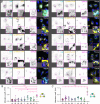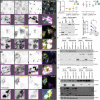Oropouche Virus Glycoprotein Topology and Cellular Requirements for Glycoprotein Secretion
- PMID: 36475765
- PMCID: PMC9888203
- DOI: 10.1128/jvi.01331-22
Oropouche Virus Glycoprotein Topology and Cellular Requirements for Glycoprotein Secretion
Abstract
Oropouche virus (OROV; genus Orthobunyavirus) is the etiological agent of Oropouche fever, a debilitating febrile illness common in South America. We used recombinant expression of the OROV M polyprotein, which encodes the surface glycoproteins Gn and Gc plus the nonstructural protein NSm, to probe the cellular determinants for OROV assembly and budding. Gn and Gc self-assemble and are secreted independently of NSm. Mature OROV Gn has two predicted transmembrane domains that are crucial for glycoprotein translocation to the Golgi complex and glycoprotein secretion, and unlike related orthobunyaviruses, both transmembrane domains are retained during Gn maturation. Disruption of Golgi function using the drugs brefeldin A and monensin inhibits glycoprotein secretion. Infection studies have previously shown that the cellular endosomal sorting complexes required for transport (ESCRT) machinery is recruited to Golgi membranes during OROV assembly and that ESCRT activity is required for virus secretion. A dominant-negative form of the ESCRT-associated ATPase VPS4 significantly reduces recombinant OROV glycoprotein secretion and blocks virus release from infected cells, and VPS4 partly colocalizes with OROV glycoproteins and membranes costained with Golgi markers. Furthermore, immunoprecipitation and fluorescence microscopy experiments demonstrate that OROV glycoproteins interact with the ESCRT-III component CHMP6, with overexpression of a dominant-negative form of CHMP6 significantly reducing OROV glycoprotein secretion. Taken together, our data highlight differences in M polyprotein processing across orthobunyaviruses, indicate that Golgi and ESCRT function are required for glycoprotein secretion, and identify CHMP6 as an ESCRT-III component that interacts with OROV glycoproteins. IMPORTANCE Oropouche virus causes Oropouche fever, a debilitating illness common in South America that is characterized by high fever, headache, myalgia, and vomiting. The tripartite genome of this zoonotic virus is capable of reassortment, and there have been multiple epidemics of Oropouche fever in South America over the last 50 years, making Oropouche virus infection a significant threat to public health. However, the molecular characteristics of this arbovirus are poorly understood. We developed a recombinant protein expression system to investigate the cellular determinants of OROV glycoprotein maturation and secretion. We show that the proteolytic processing of the M polypeptide, which encodes the surface glycoproteins (Gn and Gc) plus a nonstructural protein (NSm), differs between OROV and its close relative Bunyamwera virus. Furthermore, we demonstrate that OROV M glycoprotein secretion requires the cellular endosomal sorting complexes required for transport (ESCRT) membrane-remodeling machinery and identify that the OROV glycoproteins interact with the ESCRT protein CHMP6.
Keywords: Bunyamwera virus; ESCRT; Oropouche fever; Oropouche virus; arbovirus; bunyavirus; polyprotein processing; virus budding.
Conflict of interest statement
The authors declare no conflict of interest.
Figures






Similar articles
-
Vesicular Stomatitis Virus Chimeras Expressing the Oropouche Virus Glycoproteins Elicit Protective Immune Responses in Mice.mBio. 2021 Aug 31;12(4):e0046321. doi: 10.1128/mBio.00463-21. Epub 2021 Aug 3. mBio. 2021. PMID: 34340542 Free PMC article.
-
Efficient Expression of Oropouche Virus Nonstructural Proteins NSs and NSm.Methods Mol Biol. 2025;2893:273-283. doi: 10.1007/978-1-0716-4338-9_20. Methods Mol Biol. 2025. PMID: 39671044
-
Evolutionary Dynamics of Oropouche Virus in South America.J Virol. 2020 Feb 14;94(5):e01127-19. doi: 10.1128/JVI.01127-19. Print 2020 Feb 14. J Virol. 2020. PMID: 31801869 Free PMC article.
-
Oropouche Virus (OROV) in Pregnancy: An Emerging Cause of Placental and Fetal Infection Associated with Stillbirth and Microcephaly following Vertical Transmission.Viruses. 2024 Sep 9;16(9):1435. doi: 10.3390/v16091435. Viruses. 2024. PMID: 39339911 Free PMC article. Review.
-
Novel Reassortants of Oropouche Virus (OROV) Are Causing Maternal-Fetal Infection During Pregnancy, Stillbirth, Congenital Microcephaly and Malformation Syndromes.Genes (Basel). 2025 Jan 15;16(1):87. doi: 10.3390/genes16010087. Genes (Basel). 2025. PMID: 39858634 Free PMC article. Review.
Cited by
-
A reporter Oropouche virus expressing ZsGreen from the M segment enables pathogenesis studies in mice.J Virol. 2024 Sep 17;98(9):e0089324. doi: 10.1128/jvi.00893-24. Epub 2024 Aug 28. J Virol. 2024. PMID: 39194249 Free PMC article.
-
Addressing the emerging threat of Oropouche virus: implications and public health responses for healthcare systems.Trop Dis Travel Med Vaccines. 2025 Jan 2;11(1):1. doi: 10.1186/s40794-024-00236-x. Trop Dis Travel Med Vaccines. 2025. PMID: 39748388 Free PMC article. Review.
-
Oropouche fever fatalities and vertical transmission in South America: implications of a potential new mode of transmission.Lancet Reg Health Am. 2024 Sep 25;38:100896. doi: 10.1016/j.lana.2024.100896. eCollection 2024 Oct. Lancet Reg Health Am. 2024. PMID: 39381084 Free PMC article. No abstract available.
-
Protein-based tools for the detection and characterisation of Oropouche virus infection.EMBO Mol Med. 2025 Aug 11. doi: 10.1038/s44321-025-00291-7. Online ahead of print. EMBO Mol Med. 2025. PMID: 40790101
-
Oropouche virus: Understanding "sloth fever" disease dynamics and novel intervention strategies against this emerging neglected tropical disease.Virulence. 2024 Dec;15(1):2439521. doi: 10.1080/21505594.2024.2439521. Epub 2024 Dec 13. Virulence. 2024. PMID: 39670816 Free PMC article.
References
Publication types
MeSH terms
Substances
Supplementary concepts
Grants and funding
LinkOut - more resources
Full Text Sources
Miscellaneous

